Thermal Activation of High-Alumina Coal Gangue Auxiliary Cementitious Admixture: Thermal Transformation, Calcining Product Formation and Mechanical Properties
Abstract
:1. Introduction
2. Experimental Details
2.1. Raw Materials
2.2. Adding Calcium and Thermal Activation
2.3. Hydration Products
2.4. Flexural and Compressive Strength
3. Results and Discussion
3.1. Thermal Transformation of HACG–CH Mixture
3.2. Calcination Products of HACG–CH Mixtures
3.3. Surface Structures of HACG–CH Mixtures Calcined at Different Temperatures
3.4. Hydration Products Generated from HACG Auxiliary Cementitious Admixture and Cement
3.5. Flexural and Compressive Strength of HACG–Cement Mortar Specimens
3.6. Fracture Surfaces of HACG–Cement Mortar Specimens
4. Conclusions
- The calcining temperature greatly influenced the transformation of the HACG–CH mixture and the chemical reaction between them. With increasing calcining temperature, HACG experienced the combustion of carbon and a transformation of kaolinite → metakaolin → mullite, while CH was dehydroxylated to form CaO at a temperature below 600 °C, and then a part of CaO underwent a transformation of CaO → CaCO3 → CaO. Meanwhile, several types of hydratable products were generated from the reaction between active metakaolin and CaO at different calcining temperatures.
- A large amount of the CaO formed in the HACG–CH mixture calcined at 800 and 850 °C greatly contributed to the reaction between the active Al2O3 in the HACG–CH mixture and CH during the hydration process, in which the hydration product C4AH19 was formed.
- With elevating the calcining temperature, the flexural and compressive strength of HACG–cement mortar specimens increased until 850 °C, and then decreased rapidly at 900 °C. As compared with pure cement mortar specimens, the maximum 28-d flexural and compressive strength of HACG–cement mortar specimens increased by 5.4% and 38.2%, respectively. The optimal calcination temperature for preparing HACG auxiliary cementitious admixture was thus 850 °C.
- The finding of this investigation demonstrated that HACG powders with 20%CH addition could be utilized as an auxiliary cementitious admixture after being calcined at 850 °C, and that the flexural and compressive strength of HACG–cement mortar was much better than that of pure cement mortar, as HACG auxiliary cementitious admixture was used to replace 30% of Portland cement. This study expanded the application of HACG in auxiliary cementitious materials, but there are still many aspects such as long-term drying shrinkage and durability that need to be further investigated.
Author Contributions
Funding
Institutional Review Board Statement
Informed Consent Statement
Data Availability Statement
Acknowledgments
Conflicts of Interest
References
- Zhang, C.; Wang, P.; Wang, E.; Chen, D.; Li, C. Characteristics of coal resources in China and statistical analysis and preventive measures for coal mine accidents. Int. J. Coal Sci. Technol. 2023, 10, 22. [Google Scholar] [CrossRef] [PubMed]
- Silva, L.F.O.; Izquierdo, M.; Querol, X.; Finkelman, R.B.; Oliveira, M.L.S.; Wollenschlager, M.; Towler, M.; Perez-Lopez, R.; Maclas, F. Leaching of potential hazardous elements of coal cleaning rejects. Environ. Monit. Assess. 2011, 175, 109–126. [Google Scholar] [CrossRef] [PubMed]
- Jablonska, B.; Kityk, A.V.; Busch, M.; Huber, P. The structural and surface properties of natural and modified coal gangue. J. Environ. Manag. 2017, 190, 80–90. [Google Scholar] [CrossRef] [PubMed]
- Dontala, S.P.; Reddy, T.B.; Vadde, R. Environmental aspects and impacts its mitigation measures of corporate coal mining. Procedia Earth Planet. Sci. 2015, 11, 2–7. [Google Scholar] [CrossRef]
- Wozniak, J.; Pactwa, K. Overview of polish mining wastes with circular economy model and its comparison with other wastes. Sustainability 2018, 10, 3994. [Google Scholar] [CrossRef]
- Rosewitz, J.A.; Wang, S.; Scarlata, S.F.; Rahbar, N. An enzymatic self-healing cementitious material. Appl. Mater. Today 2021, 23, 101035. [Google Scholar] [CrossRef]
- Toniolo, N.; Boccaccini, A.R. Fly ash-based geopolymers containing added silicate waste: A review. Ceram. Int. 2017, 43, 14545–14551. [Google Scholar] [CrossRef]
- Ribeiro, J.; da Silva, E.F.; Flores, D. Burning of coal waste piles from douro coalfield (Portugal): Petrological, geochemical and mineralogical characterization. Int. J. Coal Geol. 2010, 81, 359–372. [Google Scholar] [CrossRef]
- Koshy, N.; Dondrob, K.; Hu, L.; Wen, Q.; Meegoda, J.N. Synthesis and characterization of geopolymers derived from coal gangue, fly ash and red mud. Constr. Build. Mater. 2019, 206, 287–296. [Google Scholar] [CrossRef]
- Gaddam, A.G.; Amulya, G.; Yamsani, S.K.; Gondu, V.R. Efficacy of coal gangue as a precursor of geopolymer. Indian Geotech. J. 2023. [Google Scholar] [CrossRef]
- Gu, B.; Wang, P. Analysis of factors affecting pozzolanic activity in thermal activated coal gangue. J. Build. Mater. 2009, 12, 6–11. [Google Scholar]
- Jabłonska, B. Sorption of phenol on rock components occurring in mine drainage water sediments. Int. J. Miner. Process. 2012, 104–105, 71–79. [Google Scholar] [CrossRef]
- Zhang, Y.; Xu, L.; Seetharaman, S.; Liu, L.; Wang, X.; Zhang, Z. Effects of chemistry and mineral on structural evolution and chemical reactivity of coal gangue during calcination: Towards efficient utilization. Mater. Struct. 2015, 48, 2779–2793. [Google Scholar] [CrossRef]
- Vigil de la Villa, R.; Frias, M.; Garcia-Gimenez, R.; Martinez-Ramirez, S.; Fernandez-Carrasco, L. Chemical and mineral transformations that occur in mine waste and washery rejects during pre-utilization calcinations. Int. J. Coal Geol. 2014, 132, 123–130. [Google Scholar] [CrossRef]
- Zaleska, M.; Pavlikova, M.; Keppert, M.; Lauermannova, A.; Jankovsky, O.; Lojka, M.; Jirickova, A.; Lagod, G.; Pavlik, Z. Thermally treated coal mining waste as a supplementary cementitious material—Case study from Bogdanka mine. J. Build. Mater. 2023, 68, 106036. [Google Scholar]
- Frias, M.; Rodriguez, O.; Vigil De La Villa, R.; Garcia, R.; Martinez-Ramirez, S.; Fernandez-Carrasco, L.J.; Vegas, I. The influence of activated coal mining wastes on the mineralogy of blended cement pastes. J. Am. Ceram. Soc. 2016, 99, 300–307. [Google Scholar] [CrossRef]
- Frias, M.; Sanchez de Rojas, M.I.; Garcia, R.; Juan Valdes, A.; Medina, C. Effect of activated coal mining wastes on the properties of blended cement. Cem. Concr. Compos. 2012, 34, 678–683. [Google Scholar] [CrossRef]
- Chen, J.; Jia, J.; Zhang, L.; Zhu, M. Effect of hydration process on properties and microstructure of coal gangue admixture concrete. KSCE J. Civ. Eng. 2022, 26, 3520–3532. [Google Scholar] [CrossRef]
- Song, X.Y.; Han, J.Y.; Gao, Z.H. Thermally and chemically added-calcium composite activation of coal gangue and its application in cement. Adv. Mater. Res. 2011, 1368, 1016–1019. [Google Scholar] [CrossRef]
- Zhao, Y.; Zhang, Z.; Ji, Y.; Song, L.; Ma, M. Experimental research on improving activity of calcinated coal gangue via increasing calcium content. Materials 2023, 16, 2705. [Google Scholar] [CrossRef]
- Yague, S.; Sanchez, I.; Vigil de la Villa, R.; Garcia-Gimenez, R.; Zapardiel, A.; Frias, M. Coal-mining tailings as a Pozzolanic material in cements industry. Minerals 2018, 8, 46. [Google Scholar] [CrossRef]
- GB/T17671-2021; Test Method for Strength of Hydraulic Cement Mortar. State Administration for Market Regulation: Bejing, China, 2021.
- Sahnoune, F.; Saheb, N.; Khamel, B.; Takkouk, Z. Thermal analysis of dehydroxylation of Algerian kaolinite. J. Therm. Anal. Calorim. 2012, 107, 1067–1072. [Google Scholar] [CrossRef]
- Xu, B.; Liu, Q.; Ai, B.; Ding, S.; Frost, R.L. Thermal decomposition of selected coal gangue. J. Them. Anal. Calrim. 2018, 131, 1413–1422. [Google Scholar] [CrossRef]
- Xue, H.; Dong, X.; Fan, Y.; Ma, X.; Yao, S. Study of structural transformation and chemical reactivity of kaolinite-based high ash slime during calcinations. Minerals 2023, 13, 466. [Google Scholar] [CrossRef]
- Yuan, S.; Li, Y.; Han, Y.; Gao, P. Effects of carbonaceous matter additives on kinetics, phase and structure evolution of coal-series kaolin during calcinations. Appl. Clay Sci. 2018, 165, 124–134. [Google Scholar] [CrossRef]
- Sabir, B.B.; Wild, S.; Bai, J. Metakaolin and calcined clays as pozzolans for concrete: A review. Cem. Concr. Compos. 2001, 26, 441–454. [Google Scholar] [CrossRef]
- Fernandez, R.; Martirena, F.; Scivener, K.L. The origin of the pozzolanic activity of calcined clay minerals: A comparison between kaolinite, illite and montmorillonite. Cem. Concr. Res. 2011, 41, 113–122. [Google Scholar] [CrossRef]
- Panesar, D.K.; Zhang, R. Performance comparison of cement replacing materials in concrete: Limestone fillers and supplementary cementing materials—A review. Constr. Build. Mater. 2020, 251, 118866. [Google Scholar] [CrossRef]
- Knop, Y.; Peled, A.; Cohen, R. Influence of limestone particle size distributions and contents on blended cement properties. Constr. Build. Mater. 2014, 71, 26–34. [Google Scholar] [CrossRef]
- Kiventera, J.; Perumal, P.; Yliniemi, J.; Illikainen, M. Mine tailings as a raw material in alkali activation: A review. Int. J. Miner. Metall. Mater. 2020, 27, 1009–1020. [Google Scholar] [CrossRef]
- Chakraborty, A.K. New data on thermal effects of kaolinite in the high temperature region. J. Therm. Anal. Calorim. 2003, 71, 799–808. [Google Scholar] [CrossRef]
- Hao, R.; Li, X.; Xu, P.; Liu, Q. Thermal activation and structural transformation mechanism of kaolinitic coal gangue from Jungar coalfield, Inner Mongolia, China. App. Clay Sci. 2022, 223, 106508. [Google Scholar] [CrossRef]


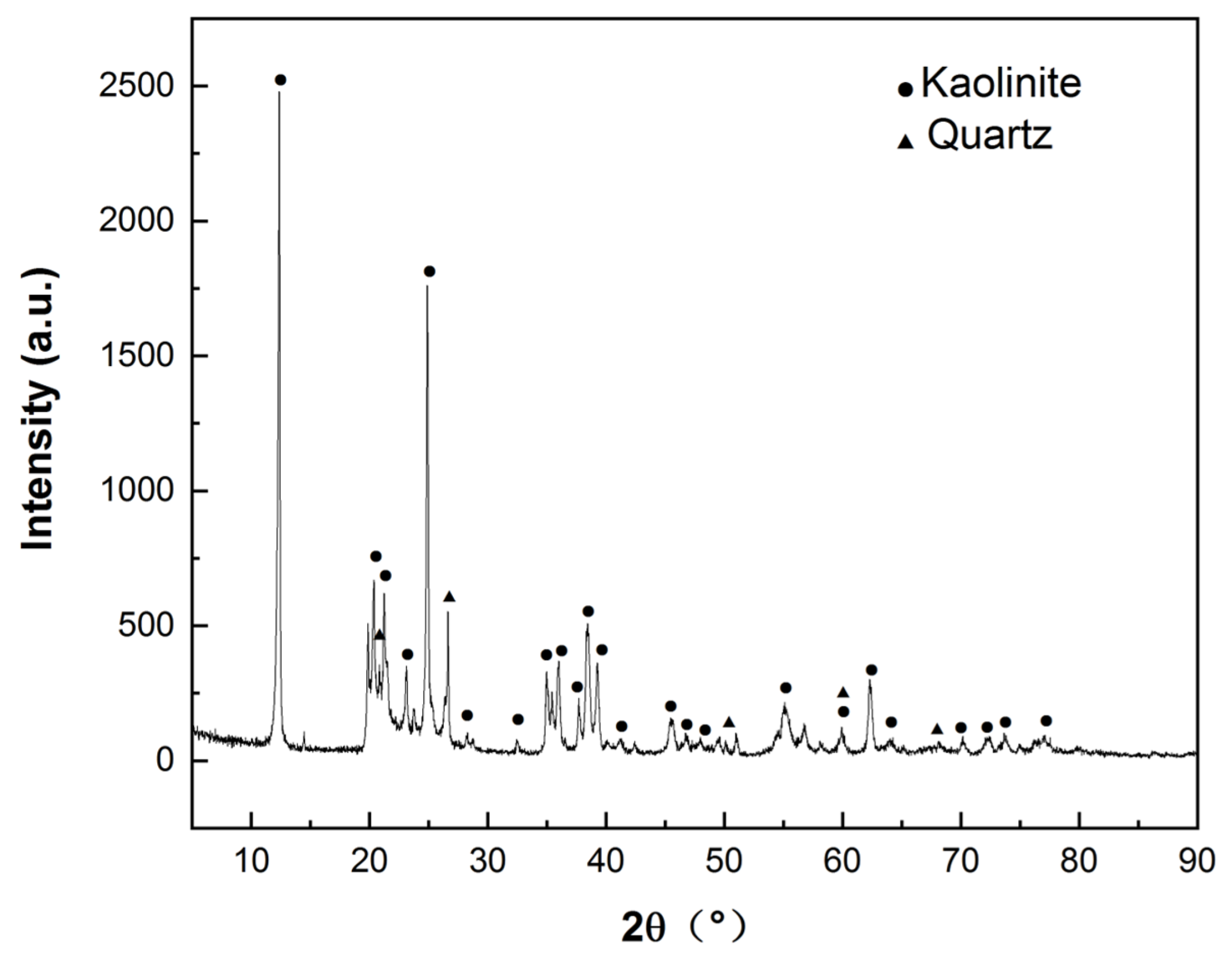
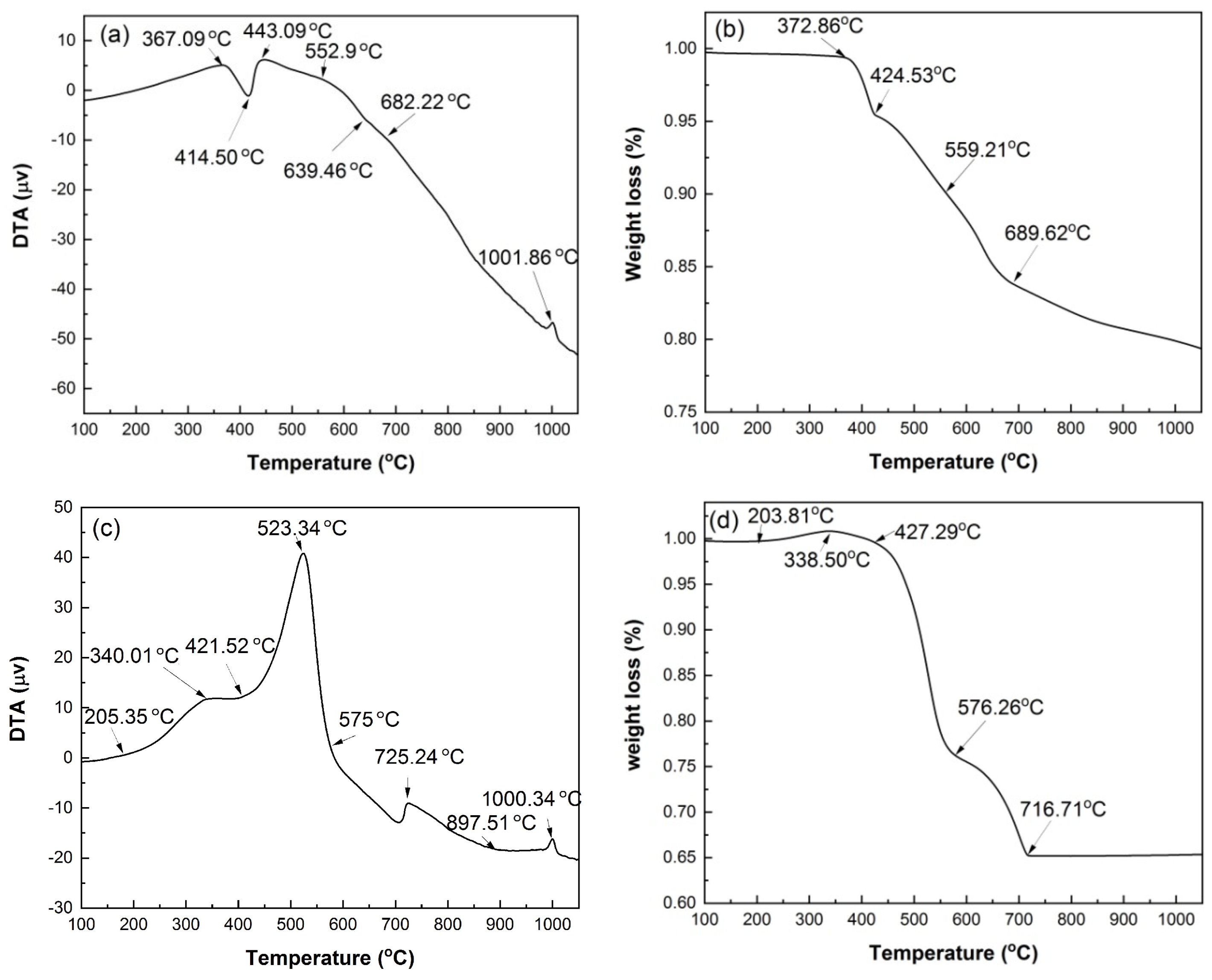
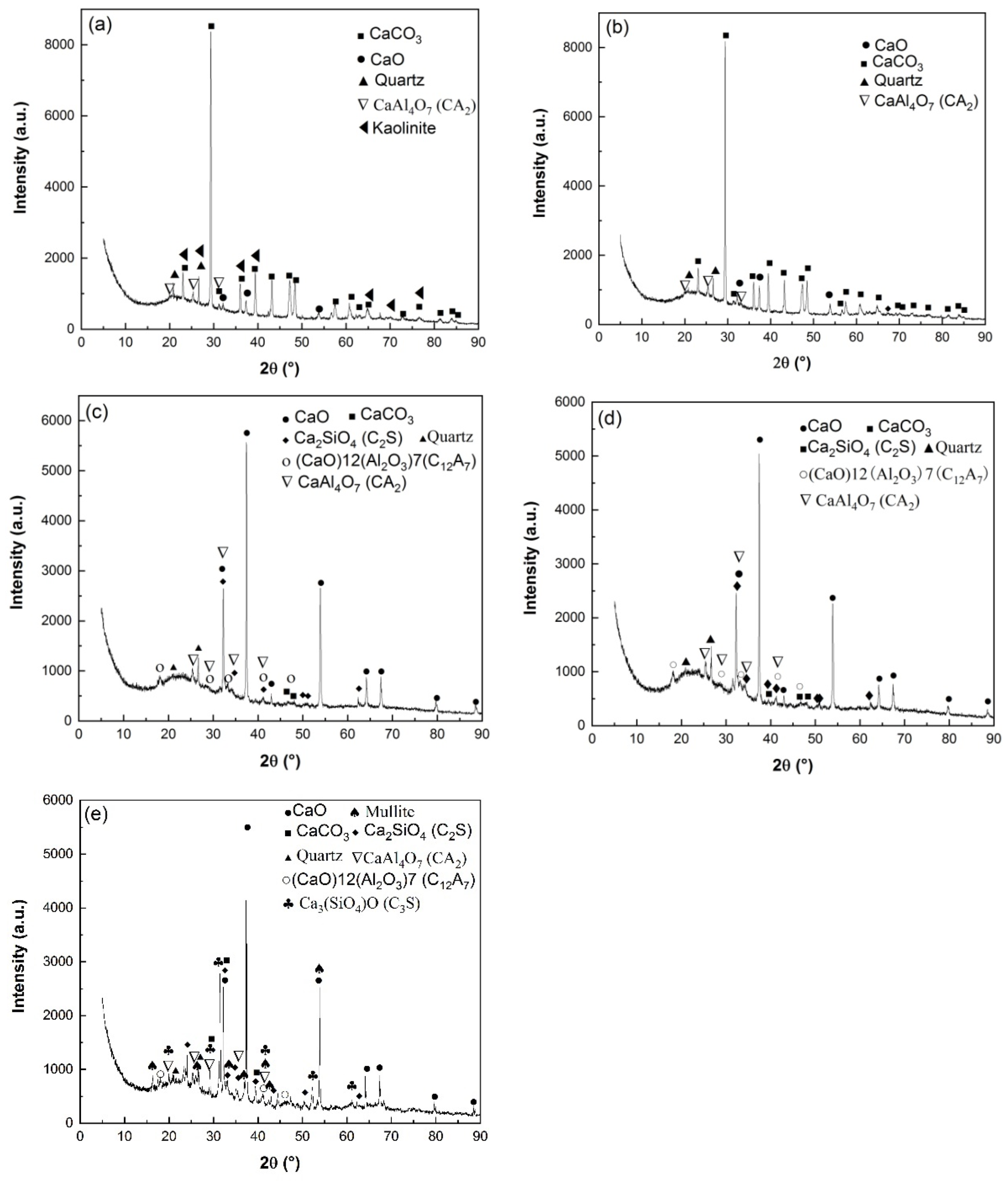
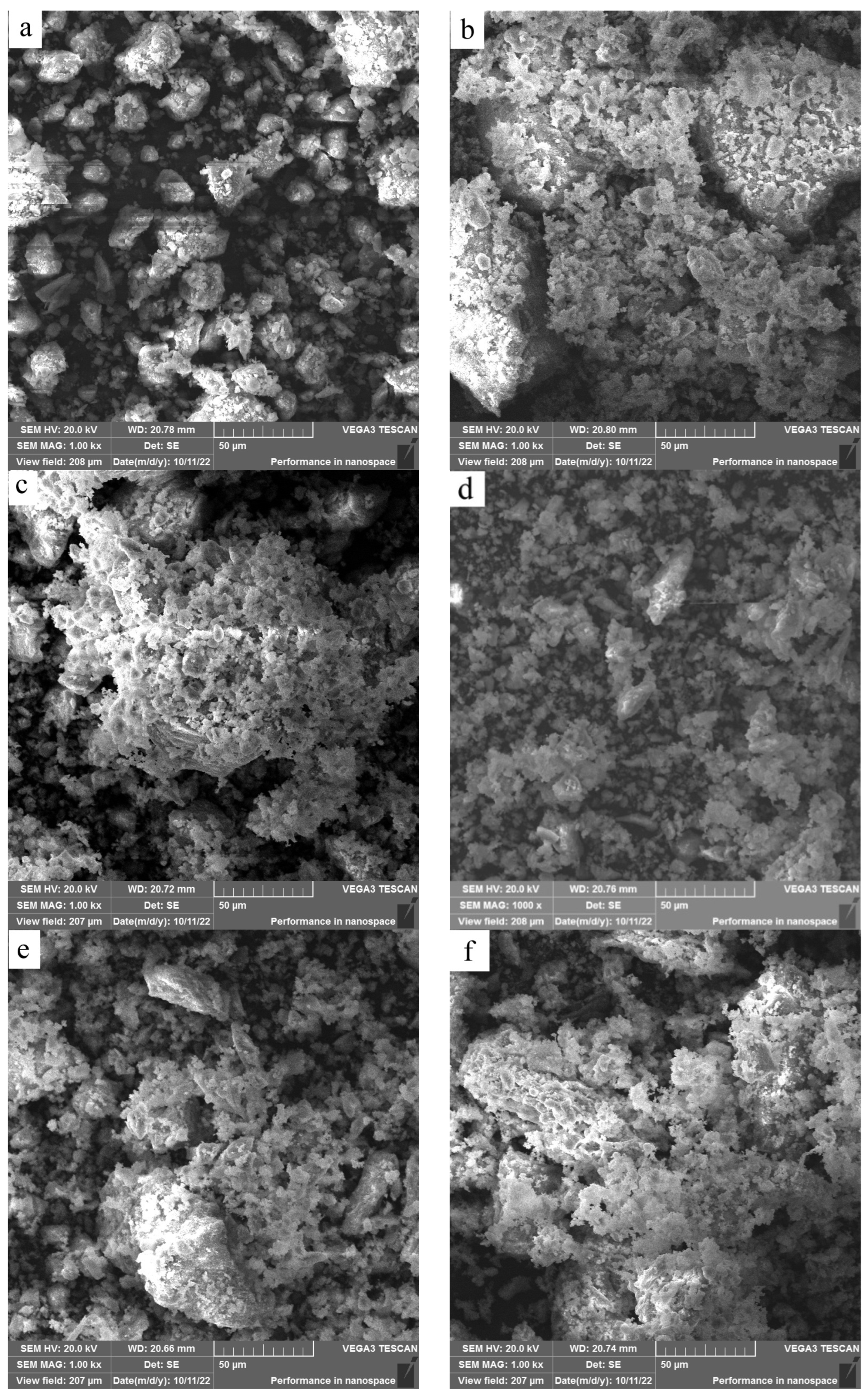
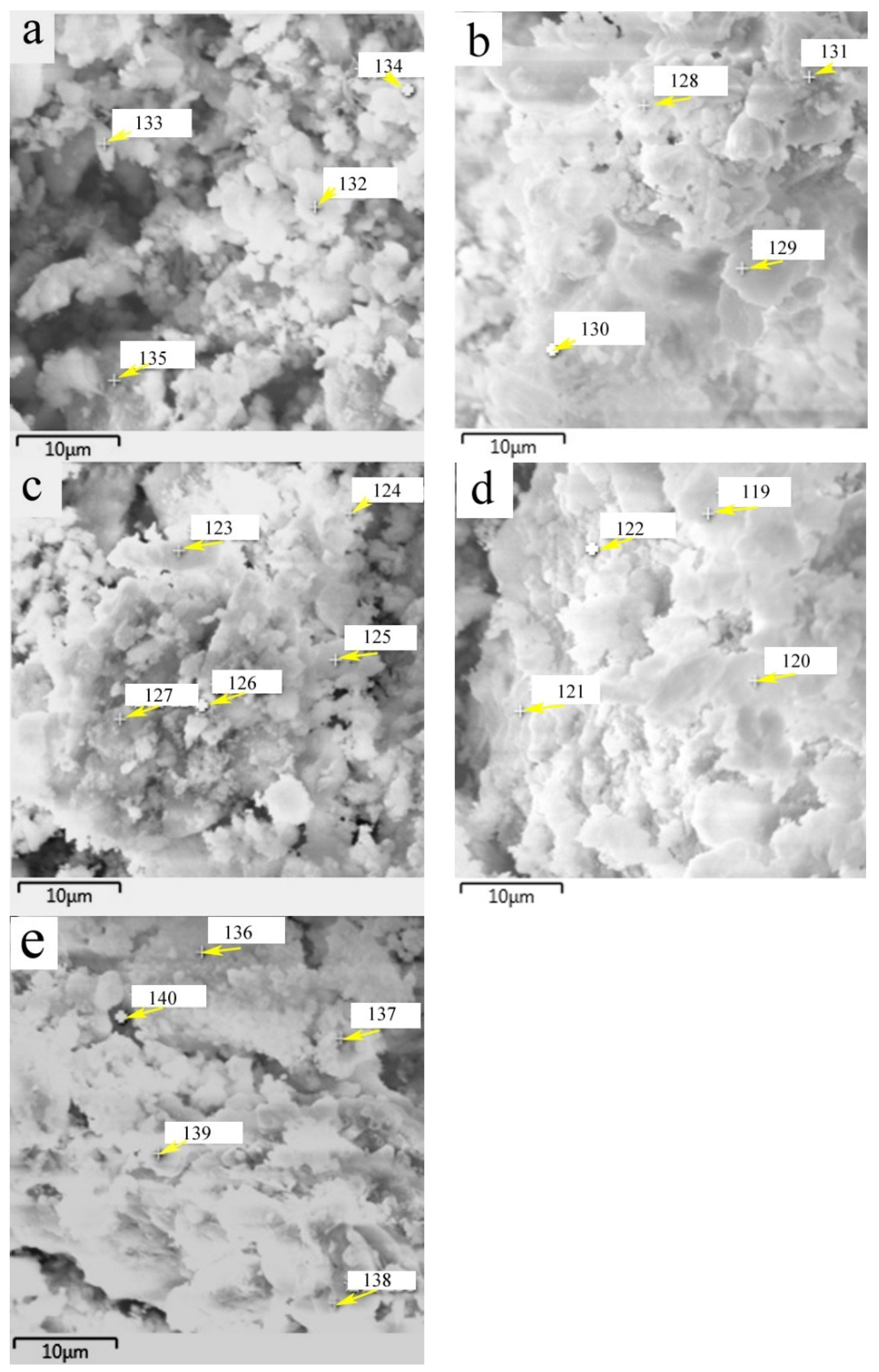
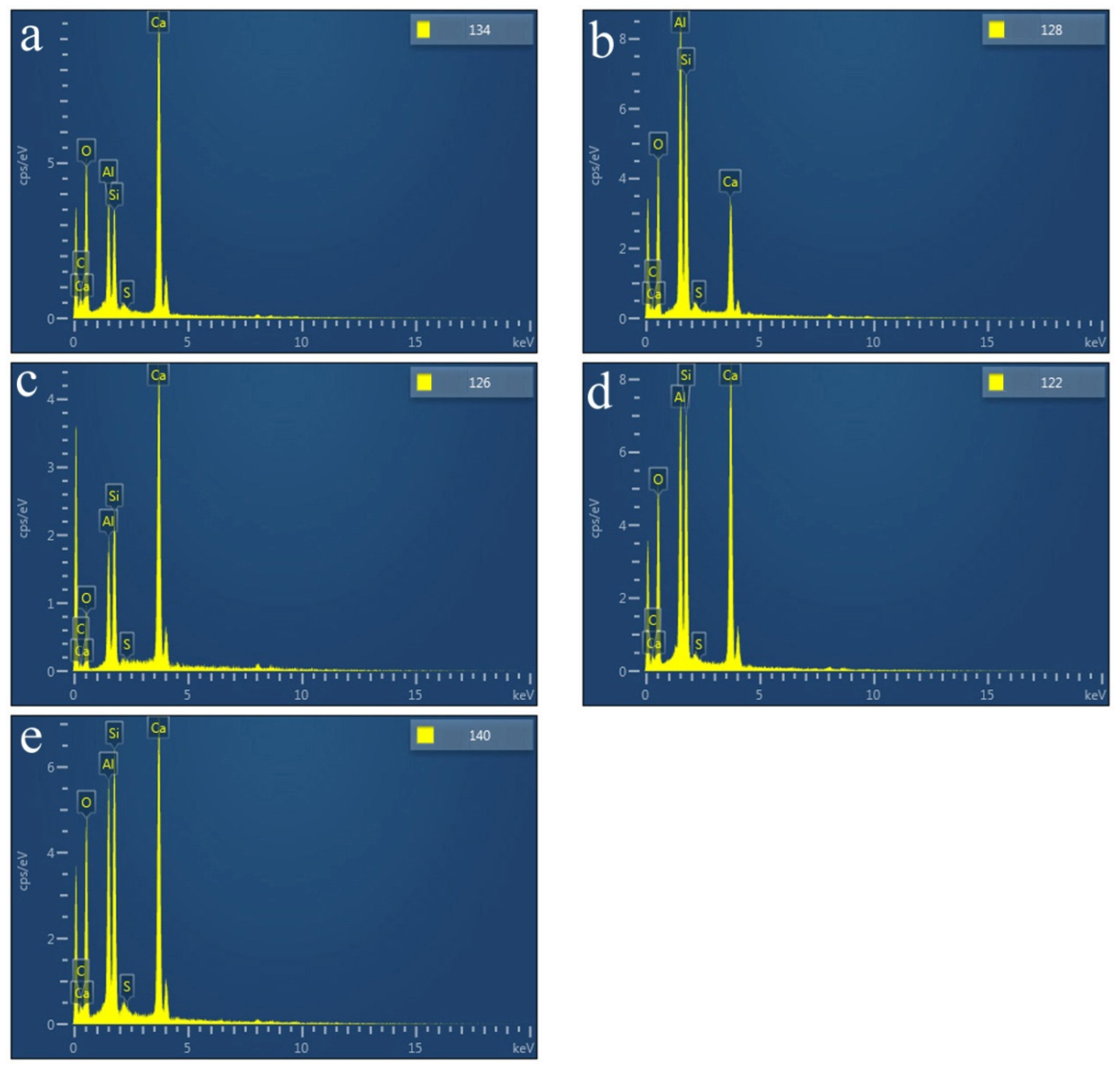
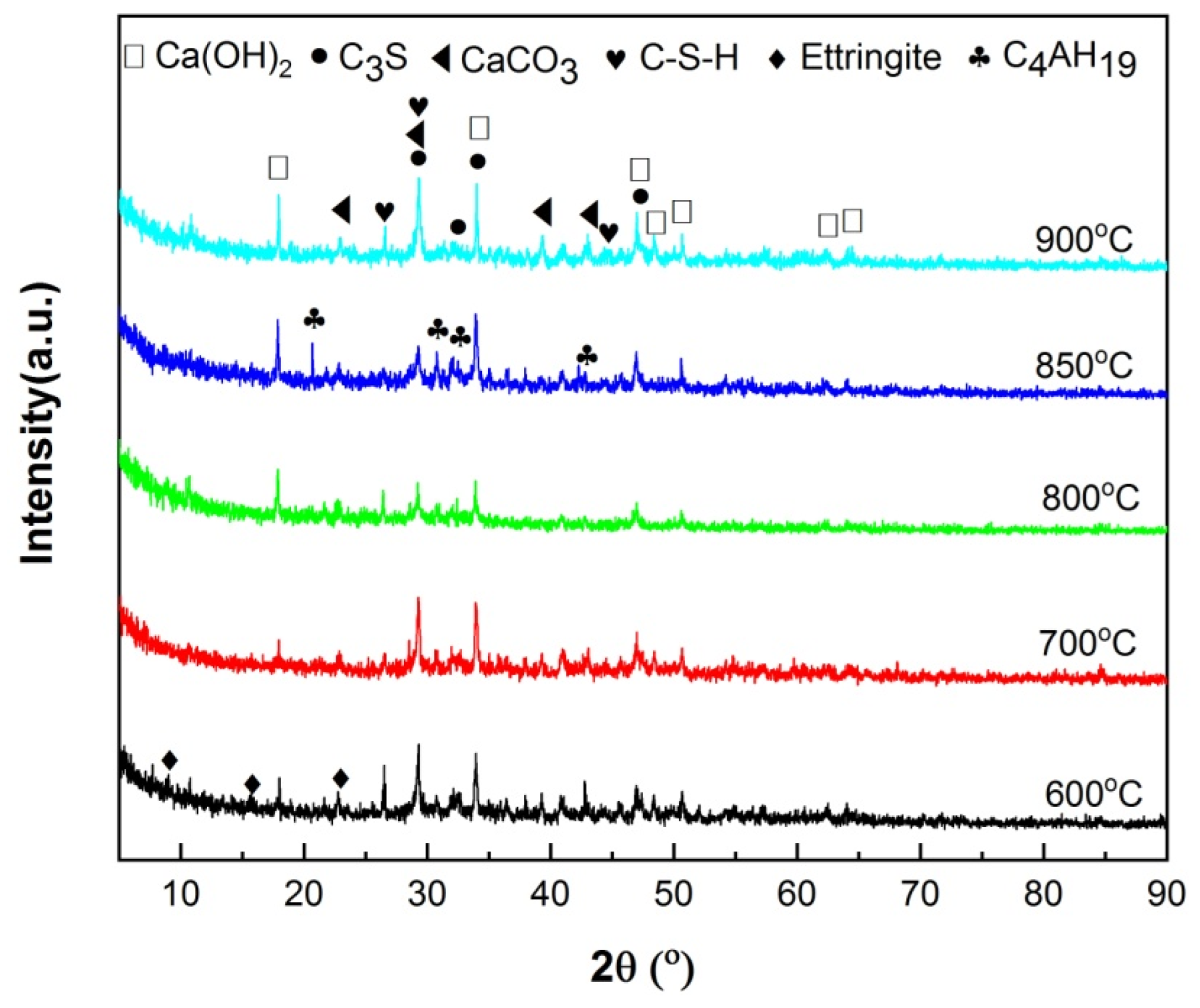
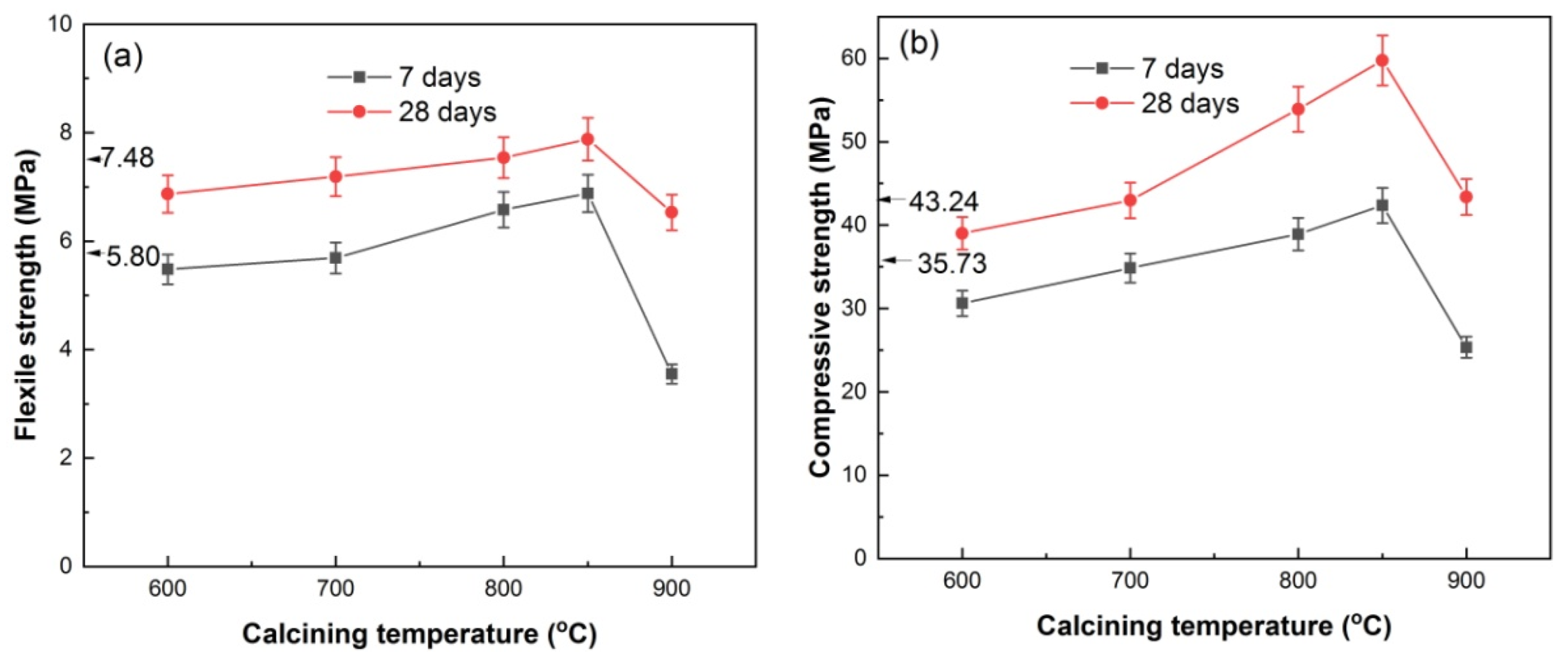
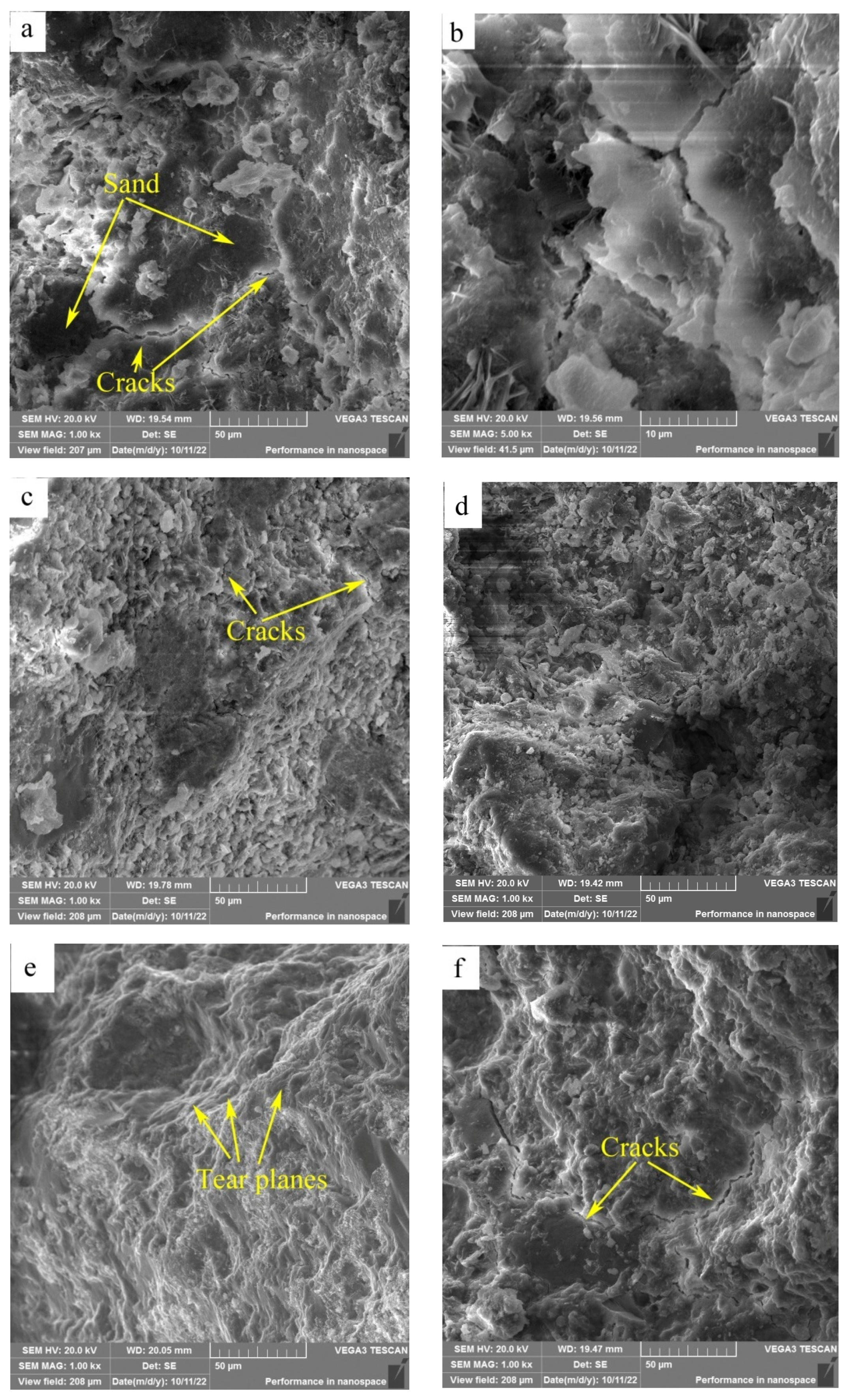


| Material | SiO2 | Al2O3 | Fe2O3 | CaO | MgO | SO3 | K2O | Na2O | TiO2 | P2O5 | Loss |
|---|---|---|---|---|---|---|---|---|---|---|---|
| Coal gangue | 52.60 | 45.01 | 0.21 | 0.11 | 0.06 | - | 0.12 | 0.04 | 0.97 | 0.03 | 0.35 |
| Cement | 21.04 | 6.03 | 3.62 | 63.85 | 2.64 | 2.21 | - | - | - | - | 0.21 |
| Temperature (°C) | O | Al | Si | S | Ca | Location | Product |
|---|---|---|---|---|---|---|---|
| 600 | 45.16 | 13.43 | 11.66 | 0.06 | 29.21 | 132 | CaO |
| 56.17 | 7.19 | 6.70 | 0.00 | 29.93 | 134 | CaCO3 | |
| 53.78 | 22.35 | 22.61 | 0.01 | 1.41 | 135 | Metakaolin | |
| 700 | 49.80 | 19.46 | 18.03 | 0.00 | 12.69 | 128 | CA2 |
| 50.42 | 7.36 | 5.87 | 0.00 | 36.32 | 129 | CaCO3 | |
| 58.00 | 17.30 | 17.79 | 0.00 | 6.78 | 131 | Metakaolin + CaCO3 | |
| 800 | 51.84 | 2.51 | 2.11 | 0.31 | 43.23 | 123 | CaCO3 |
| 11.81 | 11.70 | 11.53 | 0.02 | 64.92 | 125 | CaO | |
| 36.85 | 10.25 | 13.49 | 0.17 | 39.23 | 126 | C2S | |
| 45.67 | 4.42 | 4.15 | 0.31 | 45.45 | 127 | CaO | |
| 850 | 45.10 | 7.43 | 6.93 | 0.12 | 39.97 | 119 | CaO |
| 45.10 | 9.68 | 9.23 | 0.12 | 35.87 | 120 | CaO | |
| 52.03 | 20.27 | 20.45 | 0.00 | 7.25 | 121 | CA2 | |
| 49.87 | 13.15 | 13.00 | 0.00 | 23.97 | 122 | C12A7 | |
| 900 | 55.13 | 2.30 | 2.26 | 0.24 | 33.60 | 136 | CaCO3 |
| 45.70 | 9.12 | 9.75 | 0.09 | 35.43 | 137 | CaO | |
| 40.56 | 23.67 | 26.11 | 0.00 | 9.65 | 138 | CA2 | |
| 51.56 | 11.18 | 13.47 | 0.00 | 23.74 | 140 | C12A7 |
| Temperature (°C) | O | Ca | C | Si | Al | S |
|---|---|---|---|---|---|---|
| 600 | 50.2 | 18.2 | 14.2 | 12.8 | 4.1 | 0.6 |
| 700 | 47.8 | 13.9 | 15.8 | 20.1 | 2.1 | 0.3 |
| 800 | 44.9 | 20.1 | 12.9 | 18.0 | 3.7 | 0.5 |
| 850 | 46.3 | 21.7 | 13.4 | 14.2 | 3.8 | 0.6 |
| 900 | 48.9 | 16.7 | 16.8 | 13.4 | 3.5 | 0.7 |
Disclaimer/Publisher’s Note: The statements, opinions and data contained in all publications are solely those of the individual author(s) and contributor(s) and not of MDPI and/or the editor(s). MDPI and/or the editor(s) disclaim responsibility for any injury to people or property resulting from any ideas, methods, instructions or products referred to in the content. |
© 2024 by the authors. Licensee MDPI, Basel, Switzerland. This article is an open access article distributed under the terms and conditions of the Creative Commons Attribution (CC BY) license (https://creativecommons.org/licenses/by/4.0/).
Share and Cite
Zhang, M.; Li, L.; Yang, F.; Zhang, S.; Zhang, H.; Zhu, Y.; An, J. Thermal Activation of High-Alumina Coal Gangue Auxiliary Cementitious Admixture: Thermal Transformation, Calcining Product Formation and Mechanical Properties. Materials 2024, 17, 415. https://doi.org/10.3390/ma17020415
Zhang M, Li L, Yang F, Zhang S, Zhang H, Zhu Y, An J. Thermal Activation of High-Alumina Coal Gangue Auxiliary Cementitious Admixture: Thermal Transformation, Calcining Product Formation and Mechanical Properties. Materials. 2024; 17(2):415. https://doi.org/10.3390/ma17020415
Chicago/Turabian StyleZhang, Mingjun, Liang Li, Fan Yang, Shigang Zhang, He Zhang, Yongfu Zhu, and Jian An. 2024. "Thermal Activation of High-Alumina Coal Gangue Auxiliary Cementitious Admixture: Thermal Transformation, Calcining Product Formation and Mechanical Properties" Materials 17, no. 2: 415. https://doi.org/10.3390/ma17020415
APA StyleZhang, M., Li, L., Yang, F., Zhang, S., Zhang, H., Zhu, Y., & An, J. (2024). Thermal Activation of High-Alumina Coal Gangue Auxiliary Cementitious Admixture: Thermal Transformation, Calcining Product Formation and Mechanical Properties. Materials, 17(2), 415. https://doi.org/10.3390/ma17020415







